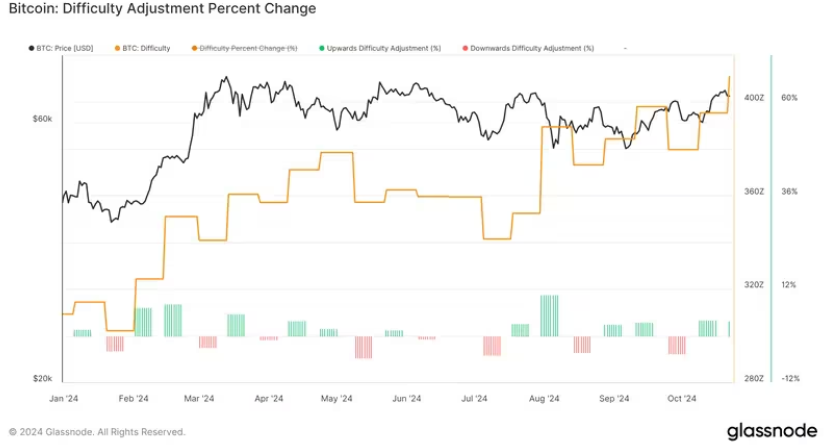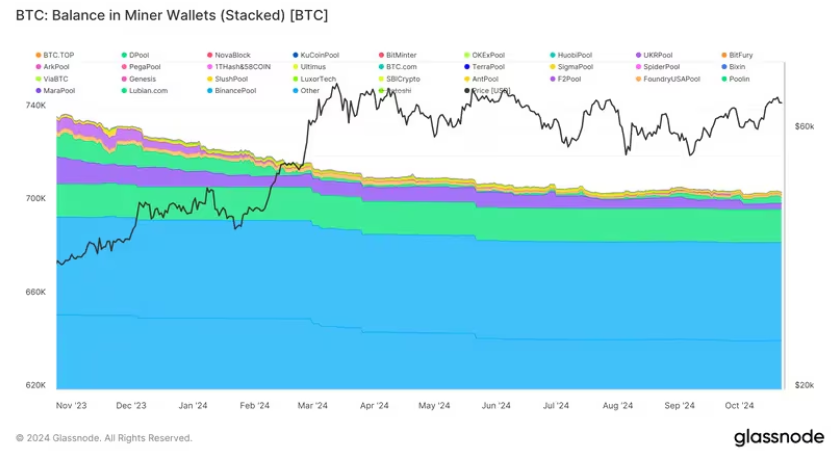The mining difficulty of Bitcoin rose by 3.9% on Tuesday, reaching a record high of 95.67T, setting a new all-time high hash rate.

Miner revenue vs. annual average (Glassnode)
- The Bitcoin mining difficulty has reached a new all-time high of 95.67T, which is in line with the record-breaking hash rate of over 700 EH/s for the first time.
- The 3.9% increase in difficulty is the 13th positive adjustment in 2024.
- Once the 365-day simple moving average of total miner revenue is confirmed, it typically coincides with a Bitcoin bull market.
According to Glassnode data, the mining difficulty of Bitcoin (BTC) reached a new all-time high of 95.67 trillion hashes (T) on Tuesday, an increase of 3.9%.
Mining difficulty measures the difficulty of mining new blocks. So far in 2024, there have been 22 difficulty adjustments, 13 of which were positive. As a result, the mining difficulty has jumped from 72T to 92T, a 27% increase since the beginning of the year.
The network automatically adjusts the difficulty every 2,016 blocks, approximately every two weeks, to ensure that an average of one block is mined every 10 minutes.
The surge in mining difficulty coincides with a record-breaking hash rate, which has also surpassed 700 exahashes (EH/s) per second for the first time. Hash rate refers to the combined computational power used to mine and process transactions on the proof-of-work blockchain.
With the increase in difficulty, the mining industry faces further pressure, as generating profits becomes more challenging. As a result, operating costs are rising, as more computing power is required to obtain more efficient mining equipment.

BTC: Percentage change in difficulty adjustments (Glassnode)
Small private mining companies are being eliminated
One of the factors contributing to the downward pressure on Bitcoin since the April halving is the unprofitable miners selling their held Bitcoin. These miners are primarily small private miners who struggle to maintain their livelihoods due to rising costs. After the halving, these miners began disconnecting from the network, leading to a 15% drop in hash rate, or started selling Bitcoin to cover their operating costs.
According to Glassnode data, we can see that miner balances have declined this year, as weaker miners realized the halving was approaching and tried to raise funds to prepare in advance.
From November 2023 to July 2024, we saw over 30,000 Bitcoin flow out of miner wallets, one of the longest miner distribution periods on record. However, we can now observe that since July, miner balances have been relatively stable and show signs of accumulation, indicating that the remaining miners are able to cope with the new environment at average levels.
The mining industry will continue to consolidate towards stronger miners, with publicly listed miners controlling a new high of nearly 30% of the market share.

Miner wallet balances (Glassnode)
The Bitcoin bull market is about to begin
The Bitcoin bull market coincides with a surge in miner revenue; as the price rises, mining revenue also increases. Glassnode data shows that on the 7-day moving average (7-DMA), total dollar mining revenue has exceeded $35 million, an increase of over $10 million from the September low.
Since the April halving, mining revenue has been below the 365-day simple moving average (SMA), currently priced at $40 million. Historically, once the total miner revenue rises above the 365-SMA, it typically coincides with a Bitcoin bull market, which has been validated in the past.







